Best Waterfall Adventures to Explore in Cebu
If you love chasing waterfalls, Cebu is a dream—dozens of cascades within a few hours of each other, each one with its own personality. On my last loop around South Cebu, I swam in jade-blue pools, scrambled through canyons, and soaked under a curtain of mist so fine it felt like rain. Here’s how to plan the ultimate Cebu waterfall adventure, with the exact stops, how to get there, fees, safety tips, and a 3-day sample itinerary.
Cebu Waterfalls at a Glance: When to Go, Map, and Essentials
Most of Cebu’s famous waterfalls cluster along the southern coast: Badian, Samboan, Ginatilan, Oslob, and Barili. Distances look short on Google Maps, but count on winding coastal roads, food stops, and the occasional carabao crossing—it’s all part of the charm.
When to go
- Dry season (Dec–May): Clearer water, easier trails, and more reliable canyoneering conditions.
- Wet season (Jun–Nov): Bigger flow and greener scenery, but watch for flash-flood risk; always check with local guides before entering canyons.
What to pack
- Aqua shoes or grippy sandals (you’ll be in and out of the water constantly)
- Dry bag and quick-dry towel
- Rash guard and sunscreen
- Cash for fees and tricycle/habal-habal rides
How to get around
From Cebu City South Bus Terminal, hop on a Ceres bus bound for Bato via Barili or Oslob depending on your first stop. For multi-fall days, I sometimes hire a habal-habal (motorbike) or rent a car for flexibility.
For a broader planning intro to Cebu, see the official destination page on Philippines.travel. And for background on the province’s most famous cascade, here’s Kawasan Falls on Wikipedia.
Kawasan Falls, Badian: Canyoneering Classic
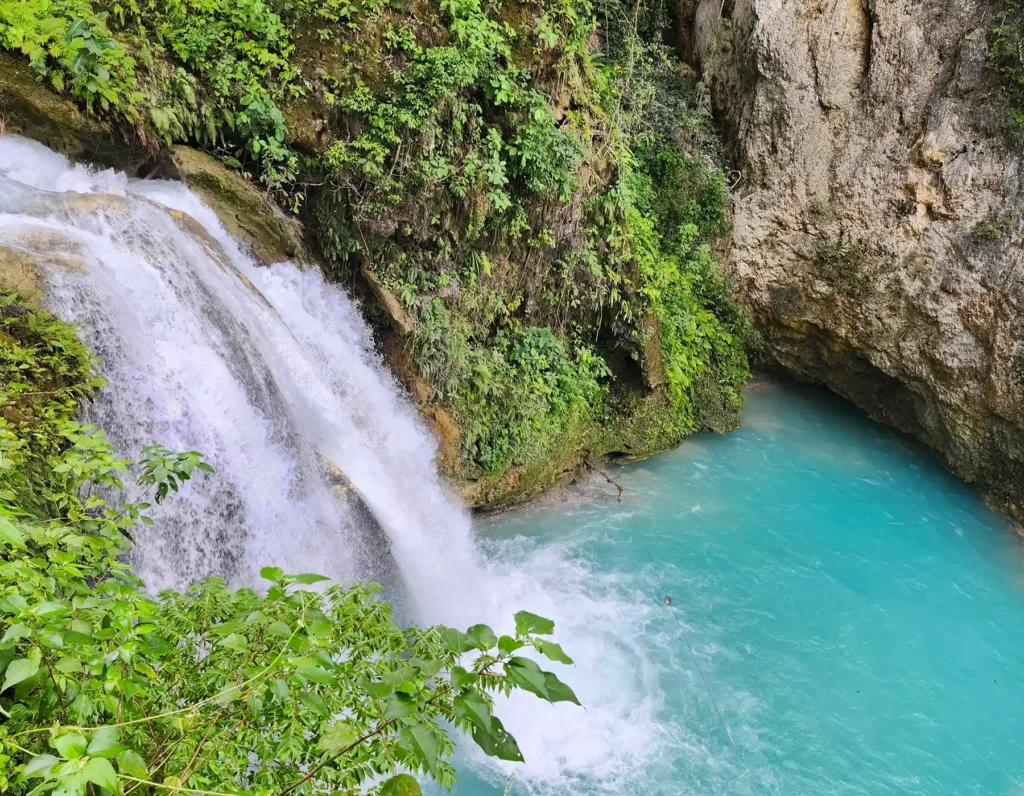
Kawasan is Cebu’s poster-child waterfall—multi-tiered, electric-blue, and made for adventure. The best way to experience it is canyoneering from upstream in Alegria all the way down to the main falls in Badian.
Fees, guides, and what to expect
Expect a package fee that typically includes helmet, life vest, aqua shoes, guide, motorbike/transport to the jump-off, and a light snack. You’ll scramble over rocks, float down gentle currents, and take optional jumps (from 3m to 10m+). If jumping isn’t your thing, there are alternate routes around the big drops—just tell your guide.
How I did it
I started around 8 AM to beat the crowds. The first jump sent a jolt of adrenaline, but floating through limestone walls under dappled jungle light was pure magic. We ended with a late lunch of grilled liempo and puso (hanging rice) near the main basin.
Tips
- Wear snug footwear—loose sandals get swept by the current.
- Pack only a phone in a waterproof pouch and a little cash; everything else can wait in the operator’s locker.
- Book a reputable, LGU-accredited operator for safety and environmental compliance.
Aguinid Falls, Samboan: 8 Levels of Fun
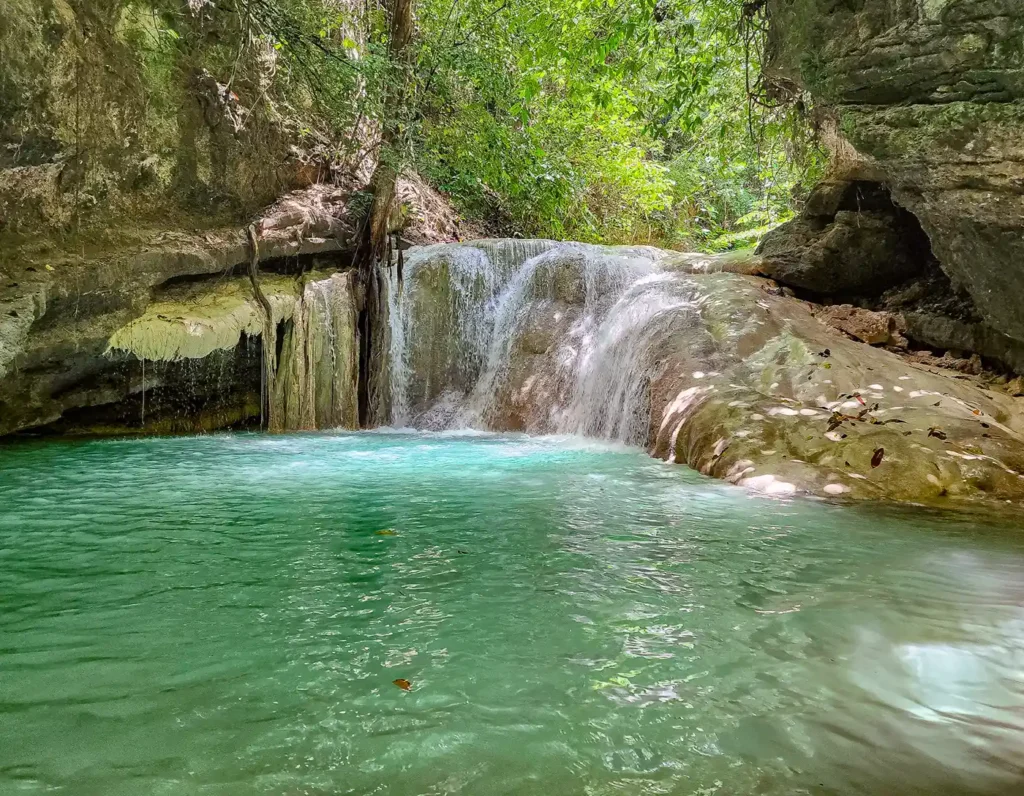
If Kawasan is for big jumps, Aguinid is for playful climbs. This multi-tiered cascade has limestone steps you can walk up with a guide, small pools to laze in, and photo-perfect curtains spilling over pale rock.
Fees and difficulty
There’s a modest entrance and compulsory guide fee (shared among your group). Difficulty is moderate: you’ll wade knee-to-waist-deep, hold ropes, and climb natural limestone with handholds. I went level by level, lingering where the light hit the jade water just right.
How to get there
From Cebu City, bus to Samboan (3.5–4.5 hours), then a short habal-habal ride to the registration area. Combine with nearby Dao or Binalayan for an epic waterfall day.
My tip
Wear a rash guard—the rock is grippy but textured. Guides will take your photos, so bring a waterproof pouch and tip them well for their patience and safety briefings.
Dao Falls, Samboan: The Canyon Walk
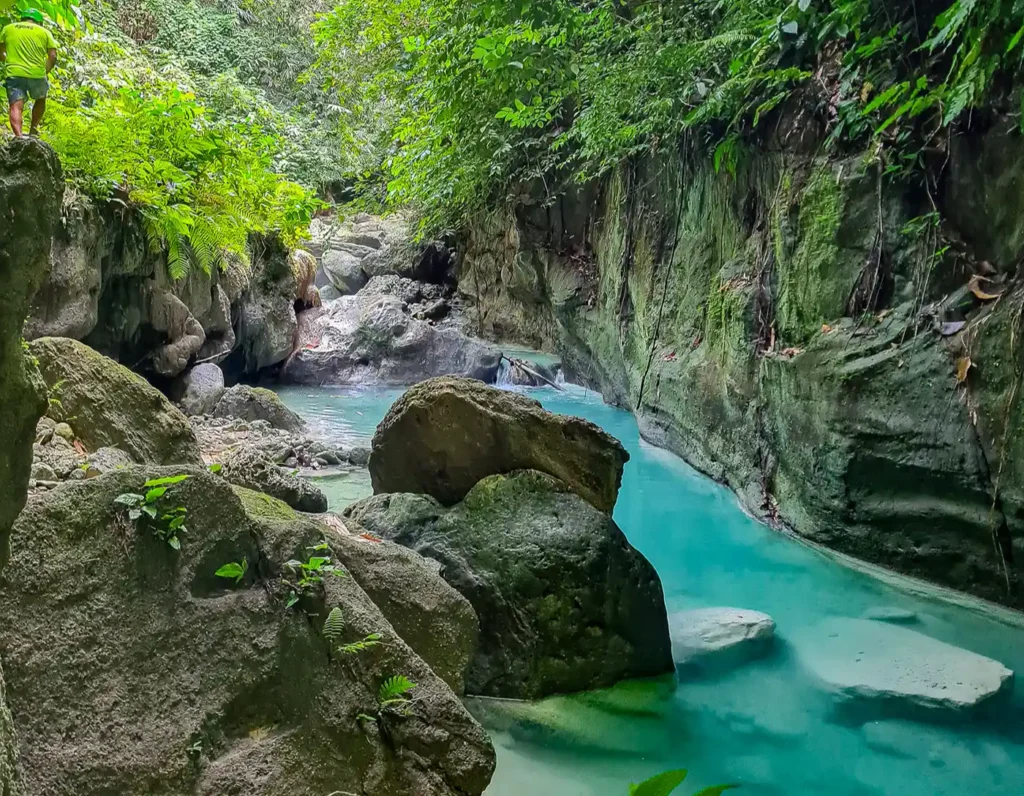
Dao is the moody one—less crowded, a little wild, and absolutely cinematic. You trek through a narrow gorge where the walls close in and the water glows a pale mint. The final amphitheater reveal is one of my favorite moments in South Cebu.
What to expect
The trail includes river crossings and slippery sections; a local guide is highly recommended. The payoff is a tall, slender fall pouring into a deep pool backed by sheer limestone.
How I did it
I timed my visit for late morning when the canyon got a touch of light. We packed snacks and took it slow on the slick bits—worth every careful step for that final view.
Safety note
If it has rained hard, ask locals about water levels before entering the canyon. Conditions can change quickly.
Inambakan Falls, Ginatilan: Turquoise Bowl and Viewpoints
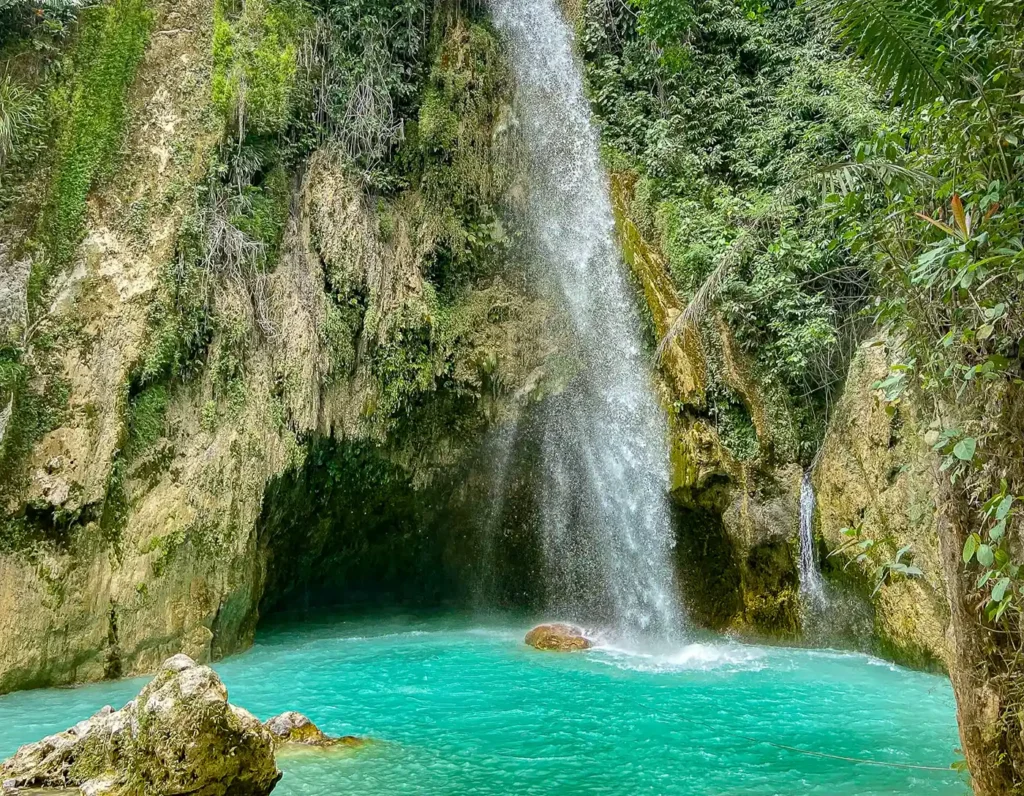
Inambakan looks like it was designed by an art director: a clean drop into a wide turquoise basin framed by thick jungle. There are short trails to smaller upper cascades, and you can scramble to viewpoints for photos that show the full bowl shape.
Why I love it
It’s a choose-your-own-pace kind of place. I’ve gone here after a big canyoneering day just to float and reset. The main pool is big enough to find your own quiet corner even when there are other visitors.
Practical bits
- Small entrance fee, optional guide.
- Habal-habal access from the highway; the road can be bumpy—hold on and enjoy the farm views.
- Come on weekdays if you can; weekends see more local families.
Tumalog Falls, Oslob: Ethereal Curtain Falls
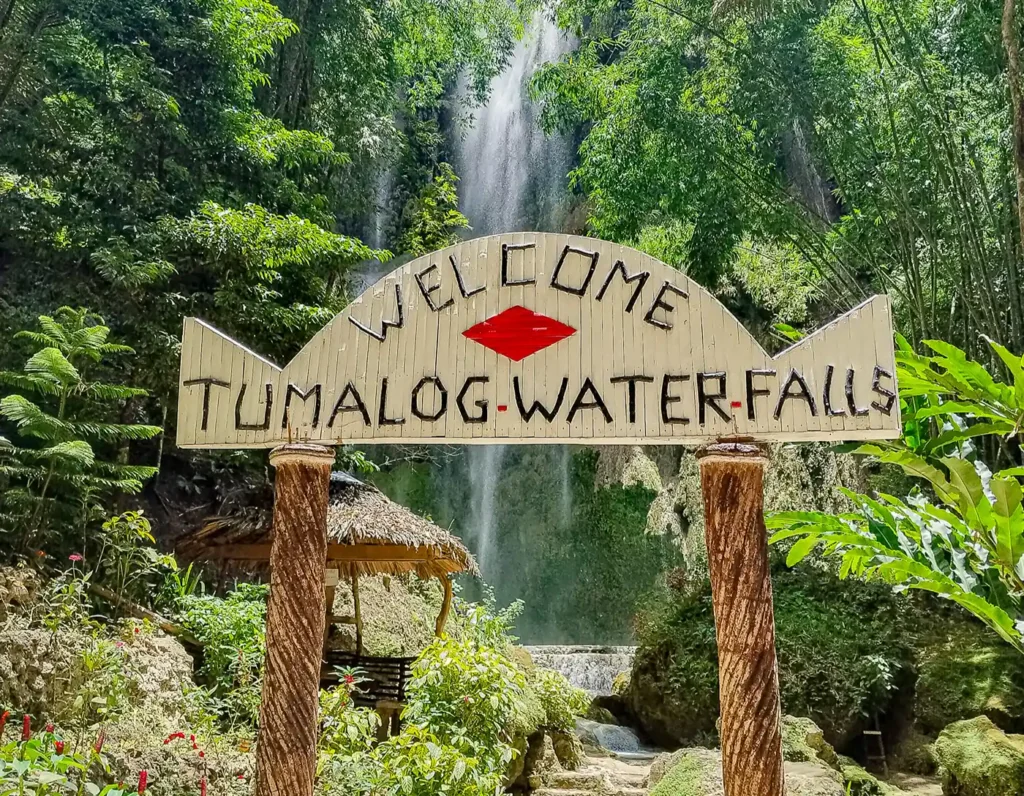
Tumalog drapes over the cliff like a giant veil, scattering into a fine mist that cools the whole valley. It’s an easy add-on if you’re already in Oslob, and the short downhill walk adds to the anticipation as the sound grows.
Good to know
- There’s an entrance fee and a short, steep access road. Locals often offer a back-and-forth ride on habal-habal if you prefer not to walk back up.
- After heavy rains, flow is stronger; in dry months it can be delicate and dreamy.
My take
I came just after a light rain and it felt like standing inside a cool cloud. Bring non-slip footwear—the rocks can be slick.
Mantayupan Falls, Barili: The Easy Big One
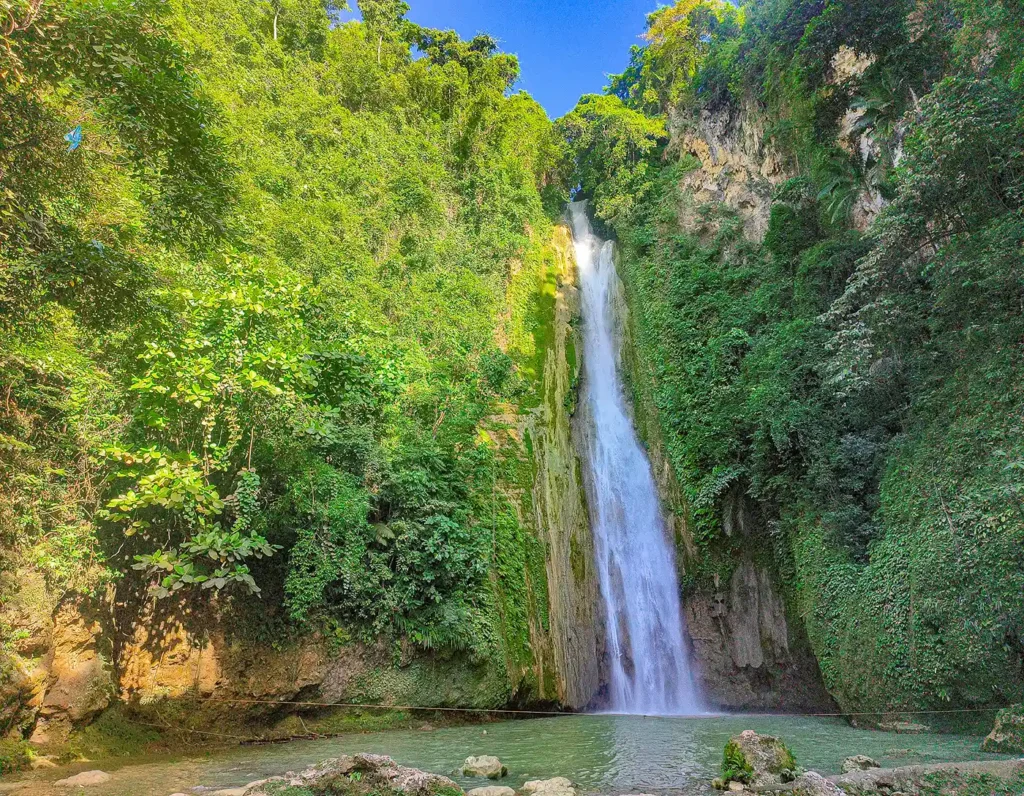
Short on time but want a towering cascade? Mantayupan is your best bet, with easy access, a sturdy hanging bridge, and a dramatic plunge pool framed by cliffs. It’s perfect for families or for your first stop straight from the city.
Why include Mantayupan
It breaks up the long drive south and gives you a big-waterfall fix without a technical hike. I like coming early, taking a few photos from the bridge, and grabbing a quick snack by the entrance.
Logistics
- Entrance fee; life vests sometimes required depending on water conditions.
- Facilities are among the better ones for Cebu waterfalls: comfort rooms, parking, and picnic areas.
Sample 3-Day Cebu Waterfall Itinerary and Budget
Here’s the exact flow I used on my last trip, starting and ending in Cebu City. Adjust based on your arrival time and energy levels.
Day 1: Cebu City to Barili and Badian
- Early AM: Cebu City to Mantayupan Falls (Barili) for a mellow warm-up.
- Lunch on the road; continue to Badian.
- PM: Quick dip at Kawasan’s lower basin (if not doing canyoneering yet). Overnight in Badian or Moalboal.
Day 2: Canyoneering + Chill
- AM: Kawasan canyoneering (book ahead, start 8 AM).
- PM: Recovery swim at Inambakan Falls (Ginatilan) or beach time in Moalboal.
- Dinner: Grilled seafood or carinderia favorites; early night.
Day 3: Samboan Stack + Oslob Curtain
- AM: Aguinid Falls (climb the tiers) then hop to Dao Falls for the canyon walk.
- PM: Tumalog Falls in Oslob for an easy, misty finale.
- Drive back to Cebu City (or overnight in the south and head back next day).
Sample budget (per person)
- Transport (bus + habal-habal): PHP 800–1,200 depending on hops
- Kawasan canyoneering package: PHP 1,500–2,000+
- Entrances and guide fees (other falls): PHP 500–900 total
- Food and water: PHP 600–1,000
- Overnights (budget guesthouse): PHP 800–1,500 per night
Responsible travel notes
- Follow local rules; register and hire accredited guides where required.
- Pack out all trash, including candy wrappers and cigarette butts.
- Respect closures due to weather or rehabilitation—there’s always another waterfall to visit tomorrow.
If you want to stretch this into a longer loop with beaches, see our suggested Cebu itinerary: 5 days and add snorkeling in Moalboal or island hopping in Mactan.